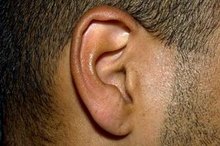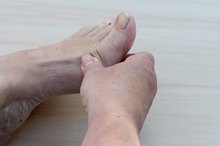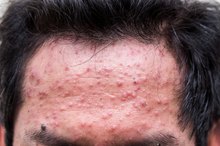What Are the Causes of a Sensitive & Painful Scalp?
Scalp pain and sensitivity occur for a variety reasons, ranging from common skin conditions and infections, to the physical irritation from scratching or harsh chemicals. Disorders affecting the nerves and blood vessels can also cause scalp tenderness and sensitivity. Sometimes you can pinpoint the cause quickly and easily. In other cases, the cause may be more elusive and require medical evaluation and treatment.
Chemical and Ultraviolet Irritation
**A wide variety of chemicals have the potential to irritate the scalp and cause pain and sensitivity.
** Although virtually any chemical can potentially cause scalp sensitivity, harsh chemicals such as hair dye, permanent wave solution and hair straighteners are more likely to cause pain and sensitivity than shampoos, conditioners and other everyday hair products. The topical hair growth drug minoxidil (Rogaine) can also cause scalp sensitivity in some people.
The sun also can wreak havoc on the scalp.
Like the rest of the skin, the scalp can sustain a sunburn, especially along a part line or in areas where the hair is thinning. Wearing a hat while outdoors is the best way to prevent a scalp sunburn.
- A wide variety of chemicals have the potential to irritate the scalp and cause pain and sensitivity.
- The topical hair growth drug minoxidil (Rogaine) can also cause scalp sensitivity in some people.
Skin Disorders
About Trigeminal Neuralgia & Ear Pain
Learn More
Skin disorders affecting the scalp can lead to scalp pain and sensitivity. Seborrheic dermatitis, for example, is a chronic inflammatory skin condition that commonly affects the scalp as well as the eyebrows, ears and folds alongside the nose. Red, flaky, greasy, itchy patches characterize this condition. Scratching these patches can lead to scalp pain and sensitivity.
Psoriasis is another common skin disorder that frequently affects the scalp, especially near the hair line. Roughly 50 percent of people with psoriasis have scalp involvement. Itchy, red, patches develop due an increased rate of skin cell growth. Psoriasis patches can be tender, a symptom that often worsens due to scratching.
- Skin disorders affecting the scalp can lead to scalp pain and sensitivity.
- Psoriasis patches can be tender, a symptom that often worsens due to scratching.
Infections and Infestations
Scalp folliculitis refers to tender, pimple-like bumps arising from the hair follicles, typically along the front hairline. This condition is believed to represent an inflammatory reaction to organisms in the hair follicles, such as yeast or mites. In some cases, it is due to a bacterial infection.
**Other bacterial skin infections, including impetigo and cellulitis, can also affect the scalp and cause a tender rash.
Lice and ringworm, a fungal infection of the scalp, typically cause intense itchiness. Scratching the involved areas commonly leads to soreness. **
People who have had chickenpox can develop shingles in later adulthood. This condition occurs due to reactivation of the varicella-zoster virus, which causes chickenpox and shingles. Shingles can involve your face and scalp and is often associated with pain and sensitivity, which usually begins before the rash appears.
- Scalp folliculitis refers to tender, pimple-like bumps arising from the hair follicles, typically along the front hairline.
- Other bacterial skin infections, including impetigo and cellulitis, can also affect the scalp and cause a tender rash.
Neurologic and Vascular Causes
About Trigeminal Neuralgia & Ear Pain
Learn More
Headaches are sometimes accompanied by scalp pain and sensitivity. With tension headaches, some people experience scalp tenderness along with a band of tightness or pressure around the head. Some people with migraines also experience scalp sensitivity along with throbbing or pulsating pain, typically on one side of the head. Giant cell arteritis (GCA), also known as temporal arteritis, can also cause headache and scalp tenderness.
This condition involves blood vessel inflammation, frequently leading to temple headaches and scalp tenderness. GCA requires urgent medical attention as it frequently affects the arteries of the eyes and can lead to vision loss.
Other neurological conditions can also cause scalp pain 4. Occipital neuralgia causes sudden, severe, stabbing pain in the back of the head near the neck. It may be the result of past trauma in some instances. Trigeminal neuralgia causes similar sensations in the face and front half of the scalp 4. Tumors of the tissues that cover the brain, called meningiomas, are a rare cause of intermittent scalp and facial pain.
- Headaches are sometimes accompanied by scalp pain and sensitivity.
- Some people with migraines also experience scalp sensitivity along with throbbing or pulsating pain, typically on one side of the head.
Trauma and Hair Loss
A blow to the head can cause temporary scalp bruising and tenderness.
With a high-energy blow, it's important to seek medical evaluation to determine whether a brain injury or skull fracture has occurred. This is especially important if the injury was accompanied by loss of consciousness, even if only for a few seconds.
For reasons that remain unclear, areas of the scalp affected by hair loss are sometimes sensitive. This symptom, known as trichodynia, affects approximately 20 percent of women and 9 percent of men experiencing hair loss, according to a study published in 2002 in the journal "Dermatology."
- A blow to the head can cause temporary scalp bruising and tenderness.
When to Seek Medical Attention
Seek medical attention for any unexplained or persistent scalp pain.
Urgent medical care is needed if you experience a significant blow to the head or symptoms that might indicate giant cell arteritis. Other warning signs and symptoms that signal the need for urgent medical evaluation include: -- intermittent or persistent fevers, especially if higher than 101 F -- eye pain or vision changes -- drainage of pus from scalp sores -- spreading redness around scalp sores or patches
Reviewed and revised by: Tina M. St. John, M.D.
Related Articles
References
- Differential Diagnosis in Primary Care, 4th Edition; R. Douglas Collins
- Expert Review of Dermatology: Sensitive Skin
- Dermatology: Hair Pain (Trichodynia): Frequency and Relationship to Hair Loss and Patient Gender
- The Dermatologist: Regional Atlas of Contact Dermatitis: Scalp
- American Family Physician: Diagnosis and Treatment of Seborrheic Dermatitis
- American Academy of Dermatology: Psoriasis
- Ranganathan S, Mukhopadhyay T. Dandruff: the most commercially exploited skin disease. Indian J Dermatol. 2010;55(2):130-4. doi:10.4103/0019-5154.62734
- Gavazzoni dias MF. Hair cosmetics: an overview. Int J Trichology. 2015;7(1):2-15. doi:10.4103/0974-7753.153450
- Datta HS, Mitra SK, Paramesh R, Patwardhan B. Theories and management of aging: modern and ayurveda perspectives. Evid Based Complement Alternat Med. 2011;2011:528527. doi:10.1093/ecam/nep005
- Carson CF, Hammer KA, Riley TV. Melaleuca alternifolia (Tea Tree) oil: a review of antimicrobial and other medicinal properties. Clin Microbiol Rev. 2006;19(1):50-62. doi:10.1128/CMR.19.1.50-62.2006
- Satchell AC, Saurajen A, Bell C, Barnetson RS. Treatment of dandruff with 5% tea tree oil shampoo. J Am Acad Dermatol. 2002;47(6):852-5. doi:10.1067/mjd.2002.122734
- Huang TH, Wang PW, Yang SC, Chou WL, Fang JY. Cosmetic and therapeutic applications of fish oil's fatty acids on the skin. Mar Drugs. 2018;16(8). doi:10.3390/md16080256
- Piccardi N1, Manissier P. "Nutrition and nutritional supplementation: Impact on skin health and beauty." Dermatoendocrinol. 2009 Sep;1(5):271-4.
Writer Bio
Dr. Ann M. Hester is a board-certified internal medicine specialist and author. She is also the creator of the Patient Whiz patient engagement app for iOS and Total en Salud health app in Spanish.







